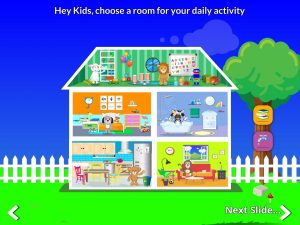
The Bluebee pal App is a free educational and interactive app which can bring your Bluebee Pal to life! Don’t have a Bluebee Pal? No problem! This free app can be used without a Bluebee Pal. The Bluebee Pal App incorporates choice making and engagement when interacting with the app. It features five different rooms with specific tasks.

Within each room, your child’s chosen Bluebee Pal can interact with varying activities, such as in the kitchen scene. Bluebee Pal can eat various foods, drink, and access different appliances and objects in the kitchen like the refrigerator, oven, mixer, water bottle, etc. During these scenes, your child will also learn different routines in the kitchen and can target specific goals listed below. The app also includes free mini-games that target language, literacy, matching, inferencing skills and imaginative play.
How to incorporate 10 Language and Learning Goals when using this free Bluebee app!

Making choices: Making choices is easy with this app. When the app begins, a child gets the option of choosing a Bluebee Pal (choice between the Sammy the Bear, Leo the Lion, Lily the Lamb, Rylie the Zebra, Partner the Monkey, and Hudson, the Puppy). After the child chooses their favorite Bluebee Pal, they get to choose their favorite color balloon, category and then the room they want to explore.
Categories: Explore categories with this app including animals, furniture, toys, outdoor activities, games, sports, art, music and much more! With this app, there are so many ways to incorporate the learning of categories as a child is playing with the app. To carryover, this goal, take screenshots of the app and with a visual of various categories ask your child to put the objects in the right category. Another carryover activity is taking a screenshot of the house and then asking your child to place the right object in the correct room with some tangible symbols or objects.
I love how the app incorporates errorless learning with specific tasks that require appropriate choices. This helps build language and learning in a fun and stress-free play environment.
Following directives: Throughout this app, the child is required to follow 1-2 step directives such as feeding Bluebee Pal, putting him sleep, brushing his teeth and much more! If your child needs more help with following directives, give prompts as necessary.
Literacy goals: This app is ideal for emerging readers! The mini-games help children recognize sounds and letters in a fun and interactive manner. With one mini-game, a child is required to put the right letter where it belongs on a qwerty keyboard.
Daily Living Skills: This app incorporates a variety of daily living skills including hygiene, cooking and cleaning up. During these opportunities, a child will be able to engage in these daily living tasks that they can relate to on a daily basis. This can be carried over into the home environment by going through the hygiene routine with Bluebee Pal and then doing the same with your child.
Actions: Learning actions is such an important skill and vital for creating grammatically correct sentences that are communicated well. This is a goal that should be facilitated and modeled as the child is playing the app. For example, the parent/educator can model, “Bluebee is ______his teeth” and have the child fill in the action. Bluebee engages in so many actions with this app so goals can be targeted in many ways and can also help build vocabulary.
Expand vocabulary: A child can expand their vocabulary by interacting with the various objects within each room. During each room activity, there is an opportunity for a child to explore different vocabulary. For example, when the child touches the water bottle, it says “water bottle”. This continues for a variety of objects in each room. Use this vocabulary during conversation to help your child store these new words in long-term memory. Also, focus on descriptive words as well!
Sequencing: When playing with this app, help your child recall various tasks in order. For example, when Bluebee Pal is in the bathroom, he first gets in the shower and gets wet, then gets washed with soap, and then finally needs to get dried with the towel or the hairdryer. When the sequence is done, review the steps in taking a shower and ask specific questions. For example, “What did Partner the Monkey do first?”
Negation: Learning and understanding negation is so important for various communicative functions such as requesting, commenting and expressing an opinion. In this app, a child has to follow directives with negations embedded it the sentences such as “Don’t forget to turn off the light.”.
Inferencing Skills and Improving Visual Awareness: Explore various puzzles, a maze and mini-games and target inferencing and critical thinking skills. Throughout the story, a child has to figure out specific situations within a context. For example, after taking a shower, Bluebee Pal is wet. What does he need to do? Does your child or student have difficulty with visual perception? In one mini-game, a child is required to find all of the Bluebee Pals within the scene which can help build those visual awareness skills.
